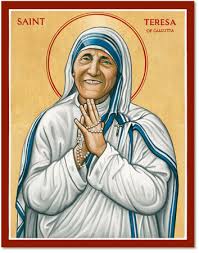“For the honour of the Blessed Trinity, the exaltation of the Catholic faith and the increase of the Christian life, by the authority of our Lord Jesus Christ, and of the Holy Apostles Peter and Paul, and our own, after due deliberation and frequent prayer for divine assistance, and having sought the counsel of many of our brother Bishops, we declare and define Blessed Teresa of Calcutta to be a Saint.” 
Pope Francis declared Mother Teresa a saint in highlight of his Holy Year of Mercy on Sunday during a canonization ceremony in front of tens of thousands of people at St. Peter’s Square.
“For the honor of the Blessed Trinity… we declare and define Blessed Teresa of Calcutta (Kolkata) to be a saint and we enroll her among the saints, decreeing that she is to be venerated as such by the whole Church,” the pontiff said in Latin.
Mother Teresa, a Nobel Peace Prize winner, was known during her lifetime as the “saint of the gutters” for her work among the poorest of the poor in India, arriving in Calcutta on January 6, 1929.
Small of stature, the Albanian nun opened missionaries of charity in over 120 countries aided by several thousand nuns and over one million volunteers, and led an austere life of her own.
When she died on September 5, 1997 at 87, her only possessions were her Bible, her prayer beads and her sari, but she left a huge legacy.

Mother Teresa’s canonization Sunday is very special for many people around the globe, but for Paris-based Albanian composer and pianist Genc Tukiçi, it’s even more meaningful. He’s the composer of Valse Celeste, a hymn dedicated to Mother Teresa, which was performed at the Vatican on the eve of the official event.
In an interview, Tukiçi said hearing that Mother Teresa was going to be a saint was a very special moment for him.
“My first reaction was very physical. I had goose bumps; my hair was standing up on my head. I had a very proud feeling of being Albanian. I also thought that an Albanian did it,” he said. “She dedicated her life to loving others, so why not me, why not us? So [much] pride but also the duty of giving a little for the good of humanity. In that context, the watchword for me, I hope it will be felt in the music, is loving others.”
Truthful to her saying: “By blood, I am Albanian. By citizenship, an Indian. By faith, I am a Catholic nun. As to my calling, I belong to the world. As to my heart, I belong entirely to the heart of Jesus,” St. Teresa devoted her entire adult life to helping the destitute and dying.
The Roman Catholic Church has more than 10,000 saints, many of whom were not elevated to sainthood until centuries after their deaths.
The case for canonization is usually initiated five years after the candidate’s death, but Pope John Paul II waived that requirement for Mother Teresa, putting her on a fast track to sainthood.
Thousands of pilgrims, including world leaders, gathered in St. Peter’s Square to witness the canonization ceremony of the “saint of the gutters”. Saint Teresa of Calcutta, as she will now be known as, was officially elevated 19 years after her death. She passed away on September 5, 1997.


